Photokina – Day 3
I must say that Photokina is an unbelievably well-organized show. Even with 1,600 exhibitors, finding what you are looking for is easy, and if you have a plan, you can see most everything you want to. The exhibits are grouped by type of product, so, for example, all the lighting equipment manufacturers are put next to each other. This is almost like all the car dealerships being on the same stretch of road in a particular city. It creates a marketplace and healthy comparison shopping.
Broncolor
We don’t carry Broncolor lighting now, and may not for while, if ever. But, the booth was across the aisle from Profoto, which we do carry, and I figured I’d check out what they had to offer.
I was extremely impressed with several of their products. The Grafit A Plus pack system was extraordinary in the amount of control and consistency it offered. The closest comparison I can draw upon is the Profoto D4, but I think the Grafit might have the edge here.

Broncolor Grafit A2 Plus pack
Because color temperature can shift about 120K per stop of power output on a strobe, you may end up with a color temp difference of 800K between two heads, one at minimum and one at maximum power. Granted, I haven’t experienced too much of this using Elinchrom and Profoto lighting, but I have seen it happen on less “well-crafted” lighting. The Grafit A Plus maintains the same color temperature at every single power level between two heads. And if that wasn’t enough, you can actually choose the specific Kelvin temperature you want the pack to create! That is pretty sweet. On the Profoto 7a you can “adjust” the temp by 300K by changing your master power setting. Granted, the Profoto system maintains temperature fairly well, but the Broncolor unit has finesse. Also, you can dial in your desired flash duration. They have a sample product shot comparison of a perfume bottle getting splashed with water, one with frozen water and the other with slightly moving water. Too cool. Add to these OCD-pleasing features a minimum flash duration of 1/10,000 sec and recycling as fast as 0.03 sec (!) and you have a nicely performing pack. A $9,000 pack, but who says money doesn’t buy happiness?
The other really innovative pack is the Verso A series. The Verso A is a studio pack that can dock onto a special battery and retains studio-like performance in the field. Broncolor added a 2400Ws pack, the A4, to the existing 1200Ws A2. This is the most powerful location pack I know of, short of running an AC pack off a generator. Truthfully, this pack doesn’t weigh much less than a gas generator. Actually, it weighs a ton. If you can actually lift it and/or afford it, you can enjoy your 650W modeling lights (!) and 2400Ws of blinding power at work. Add the incredibly designed Para FB 10.5’ focusable, self-collapsing parabolic reflector for another $7,000 and you have the hot setup. Amazing, this Bron gear makes Profoto Pro-7 look affordable. I’m not going to lie; the Broncolor equipment appealed to my meticulous side.

Broncolor Verso A2 Plus pack and battery
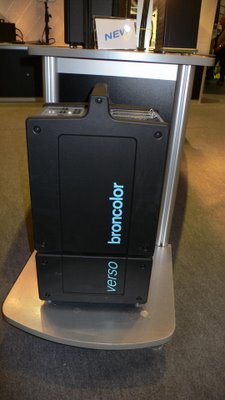
Broncolor Verso A4 Plus pack with battery attached - that pack is almost as tall as a table!

Julie standing in front of 10.5' Broncolor Para FB
Elinchrom
There has been CGI mock-up pictures on the Swiss Elinchrom site for a few months now of a radio transmitter system. The US site had no mention of it, and actually there are some products that never make it into the US for distribution. I surely hoped this wasn’t one of those times. We are dealers for Pocket Wizard, so what more could we possibly want from a wireless triggering system? Well, I love the Elincrom Ranger RX packs for location shooting. As I’m sure I mentioned a thousand times already, they are light, fast, long-lasting, and weather sealed for half the price of other systems.
The EL Skyport system is a wireless radio system that allows you to control up to four different groups of lights remotely from the hot-shoe transceiver or computer. It is compatible with all Elinchrom RX moonlights and pack systems, plugging in to a dedicated digital interface socket. Apparently, the Skyport is poised to steal some wind from Pocket Wizard’s sails (and sales). The Skyport system adds some interesting features at a much lower price. The Elinchrom version will be sold in three different kits: Universal Trigger Set, RX Trigger Set, and Computer Remote/RX Trigger Set.
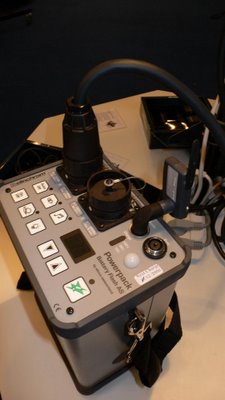
Elinchrom Skyport RX Transeiver on Ranger RX pack with 90deg adapter
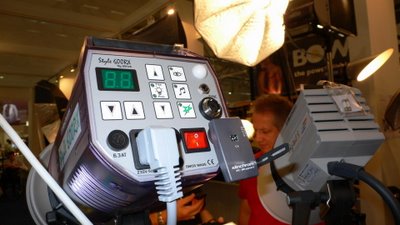
Elinchrom Skyport RX Transceiver on Style 600RX monolight
The Universal Trigger Set is basically like Pocket Wizard, except with 8 channels and 4 groups. The transceiver that goes in the hotshoe is much, much smaller and lighter. The receiver has a rechargeable battery good for 30 hours. The set of two will sell for about $150. Yeah, that’s for a transmitter and a receiver. A Pocket Wizard Plus II runs $189 for one transceiver, and you typically need two.
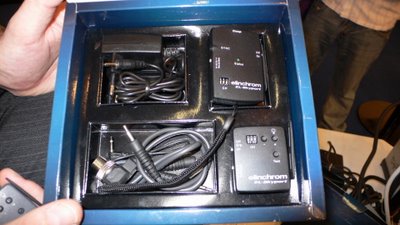
Elinchrom Skyport Universal Trigger Set
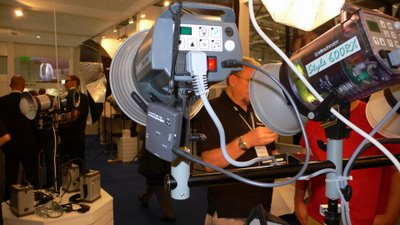
Elinchrom Skyport Universal Receiver on D-Lite monolight
The RX Trigger Set is more interesting. If you use Elinchrom RX lights, you can plug these tiny receivers in directly, without a sync cord, and control everything remotely. From the transmitter, you can select one group or all lights at once, and adjust modeling light intensity, power output in 1/10 f-stops, and fire the lights. The nice thing about grouping is that you can put your main lights in 1, background lights in 2, fill lights in 3, hair light in 4 and change the overall power of the whole setup (up to 64 heads) without affecting the lighting ratio. Or, turn up an entire group without touching your other lights. All this is possible from a transmitter that is about the size of two CF cards. The other nice thing I like was that the RX Transceivers that plug into the lights/packs pull power from the port – no batteries to check. This kit with one transmitter and two receivers will cost about $200.
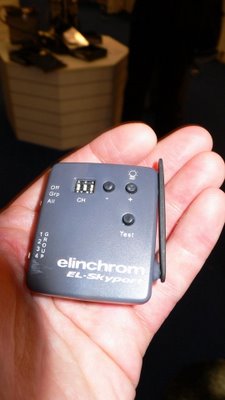
Elinchrom Skyport Transmitter
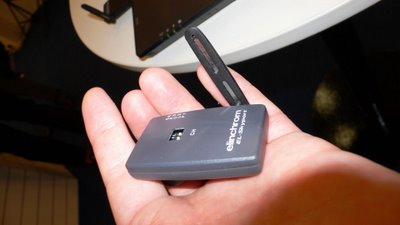
Elinchrom Skyport RX Transeiver
The Computer Remote/RX Trigger Set takes the same kit above and adds a USB nub with an antenna. Plug it into your laptop or studio computer and you can control even more parameters. The software will automatically find all RX transceivers and correctly identify models and number of heads plugged in. You can program in sequencing and even save an entire studio lighting setup and reload it to your lights at a later date. This kit will retail for $250.

Elinchrom Skyport USB Computer Transeiver
See why Pocket Wizard is sweating it? I’m excited because I won’t have to keep running to my Ranger power packs while I’m on location. Now lights can be set up in hard to get places, without worrying about adjustment and fine tuning. Elincrhom should have FCC approval by the spring. Gotta love the government.
The D-Lites have finally gotten to the US. D-Lites are value-priced Elinchrom-quality 200Ws and 400Ws monolights. I think they’ll make a great third light to an existing two light kit, or as a low-cost, high-quality entry-level studio setup. The initial kit includes two monolights, two softboxes, two Manfrotto stands, and carry bags. I’ll check pricing when I get back, but I think the kit is in the $700-800 range. That’s a ridiculously low price for Swiss-made lights that take all Elinchrom light modifiers. They recycle in less than a second and have a flash duration of about 1/1000 sec. I don’t how Elinchrom pulled that one off. I talked to the head of UK sales and he told me that they took some units to demo at a photo show and sold 100 kits in 2 hours. I can see why. I should have these kits in stock in the next couple weeks, as they make their way overseas.

Elinchrom D-Lite monolight

Elinchrom D-Lite monolight
JOBO
You can already read JOBO’s big news in an earlier blog entry where I did a full review of the Giga Vu Pro Evolution. Still a great device. I did find out that their SD-to-CF adapter will support high-speed transfer. This is great, because I tried a “brand X” adapter and only got 800K/sec instead of the 8MB/sec transfer rate of the GVPE. I’ve ordered these as well.
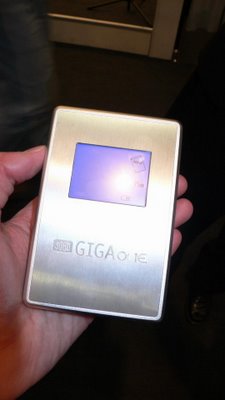
JOBO Giga One in aluminum finish
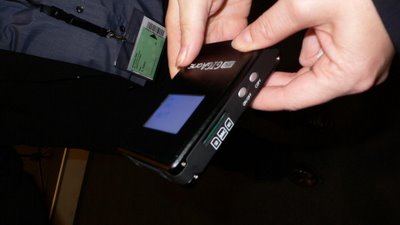
JOBO Giga One in new black finish
I also got to see the newly restyled Giga One device. It is an inexpensive hard drive backup device with no image preview. You can hook these up to the GVPE for additional capacity via USB. I like the new, cleaner look and the black option is nice as well.
Sekonic
I found out just days before I left about the new L-758DR meter. I personally own and use a Sekonic L-558R DualMaster meter. How could they improve the perfect meter? By adding a USB interface that allows you to calibrate for up to three different cameras. First, you shoot a Sekonic gray step target, then read the luminance values in Photoshop and enter them into the Sekonic software. Then, the software calculates your camera’s dynamic range. You connect the USB plug and download the calibration into your meter. Besides the DR calibration, it also corrects for any variation in actual sensor ISO. The camera might say ISO 100, but it might be ISO 110, for example. The display on the meter shows dots on the analogue scale so you can see if your camera can handle the exposure range of a given scene. Great idea to improve an already invaluable tool for studio photographers. Sekonic reinvented the wheel, but in a good way. We should be getting these by the end of the year, at a retail price of $499.

The new Sekonic L-758DR meter
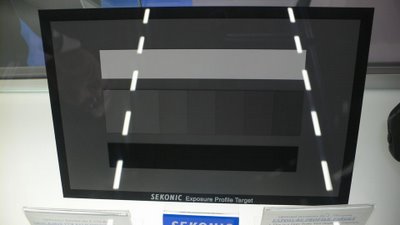 Sekonic Exposure Profile Target (please excuse the reflections in the glass)
Sekonic Exposure Profile Target (please excuse the reflections in the glass)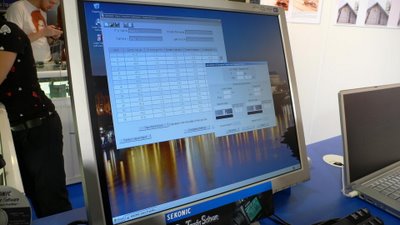
Sekonic calibration program
Canon Update
I went back to the Canon booth to play with the new backup device, the M30. It reads all Canon RAW formats, JPG, and TIFF files. No DNG support. Download speed is about 4MB/sec. I’d have expected Canon to make high-speed transfer a priority, so let’s hope that the final version is improved. I really like the consistency between this unit and the EOS line. Controls are familiar and the unit runs on a standard BP-511A Lion camera battery (same as in the 10/20/30D and 5D). Pricing for the 80GB model was estimated at 700 Euro, a bit steep considering its limitations. Not sure about US pricing or availability just yet.

Canon M30 storage device
Leaf Update
When I came back for a product brochure for the LFi, there still weren’t any available. I was able to talk to a company representative from Denmark, who answered some of my questions. Leaf decided to do their own camera in cooperation with Sinar in order to release themselves from the hold Hasselblad currently has on them. They will continue to make backs for other brands as long as those brands support Leaf, but this LFi system should give them some independence. He believed that the Schneider PQ and PQS lenses in Rollei 6008 mount are much better optically than the H-series Hasselblad lenses, when used with Leaf digital backs. Regarding the sync speed, 1/1000 sec is only possible when using newer PQS lenses. When using older PQ lenses, 1/500 sec is the max sync. Another interesting fact about the camera is that it uses a “smart” mirror. Instead of being spring-loaded, the mirror is moved with a stepped motor and can be returned to viewing position slower and more gently if desired. This should eliminate unwanted mirror vibration from moving the camera during multi-shot sequences. Additionally, the strange looking handle allows front-to-back rotation to provide maximum comfort when using the camera with either the 90 deg prism or waist-level finder.
Good news for existing Leaf Aptus customers: Leaf had a prototype pull-out rubberized viewing hood for the LCD display. This should prove to be invaluable for outdoor use. Also, Leaf is updating the current line of backs to the s version. So you can have your Aptus 75 upgraded to a 75s. According to Leaf, forget about the buffer – just shoot as many shots as you can at one every 0.8 sec. Pretty good when you consider that these are 39MP 16-bit files.
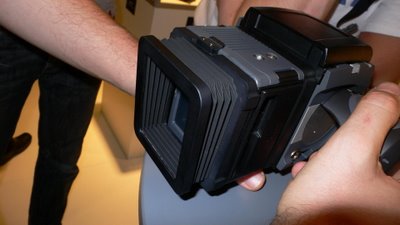
New collabsible sun shade for Leaf Aptus
Metz
I was told about a new 58AF-1 digital flash unit that sounded really intriguing. It basically can do everything a Nikon SB-800 can do on a Nikon dSLR. The 58 can be a Master and control 4 groups in 4 channels, as well as act as a Remote, just like the SB-800. It supports full i-TTL even in wireless mode, and adds some additional functionality that Nikon doesn’t. There is a second, smaller flash on the main part of the unit. This allows you to set the main strobe to bounce off the ceiling and use the secondary flash for face fill and catch lights in the eyes. Also, the Metz has a built-in photo eye, which can be activated for non TTL operation as a ballroom light, or additional light in a studio setup. The flash unit feels really solid and well made, yet lightweight, just like most of the German-built Metz strobes. As an added future-proofing measure, the 58 can be connected via USB to your computer to update the firmware. Free updates can be downloaded from the Metz website. Metz and Bogen, the US distributor, are looking at offering the 58AF-1 for less than an SB-800. All-in-all, I think this is great news for Nikon customers. There will also be a Canon version with E-TTL II support.

Metz 58AF-1
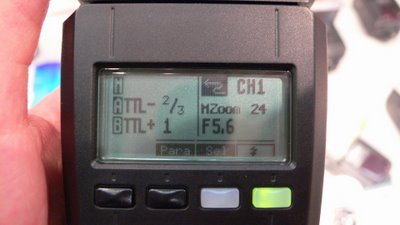
Metz 58AF-1 in Commander Mode
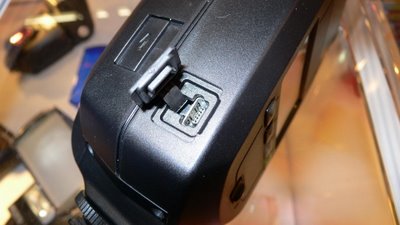
USB port for updating firmware
With all the excitement surrounding the M8, and the fact that Metz is the only company that makes TTL-compatible flash units for Leica (and more specifically the M8), I studied the line-up a little more closely. While the SF24D is nice and compact, there is no option for zooming or for bounce flash. I took a look at the 36AF-4C. It’s a small push-pull-style zooming flash with bounce for Canon E-TTL. I believe if Metz can adapt this flash to Leica TTL (and why couldn’t they?) this unit would be the obvious choice for the M8. The focal length coverage of 28-85mm is perfect, and the size and weight would balance nicely. Sure, the 54MZ-4 is wonderful, but it’s just overkill on the M8, and looks bigger than the camera. The 36 about $150 and still feels German-built. I passed along my ideas to the Metz specialist at Bogen and to the Metz representatives in the booth.

Metz 36AF-4C for Canon
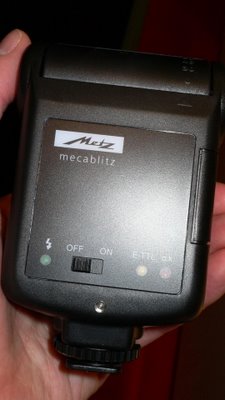
Very simple operation (on/off switch)
Pentax
The 645D remains vapor-ware. Just another camera behind glass. I think the mock-up looks very nice, but it also looks like the one I saw at the last PMA in Orlando. This product may never make it to market, but maybe PMA 2007 holds some glimmer of hope.

Pentax 645D - not reality yet
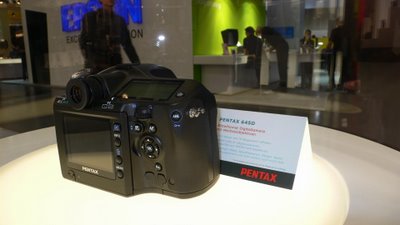
Pentax 645D - not reality yet
On to Wetzlar
Day 3 was my final day at Photokina. I felt that I saw everything I wanted to. Today, Julie and I hitch a ride to Wetzlar with Christian (from the video interviews) and Jason Schneider, previous editor of Popular Photography. With Christian’s German driving style and so much to talk about from the past few days, the two and a half hour drive should prove interesting.
For the next few days we’ll be attending the LHSA annual meeting and photo trip. 140 Leica devotees are attending this event. Never in the history of the LHSA has a meeting ever been held in Germany, let alone the birthplace of Ernst Leitz and Leica Camera. We’ll be going on a factory tour, hearing presentations on Leica past and future, and hopefully taking some great pictures of the German countryside. I’m very excited and looking forward to meeting a whole group that appreciates Leica as much as I do.

Cologne at sunset - D-Lux 2


5 Comments:
Re: your visits to Leaf and Sinar.
Too bad you didn't cross the lane where the Franke & Heidecke booth is located. The guy responsible for the inner technical design of the LFi/Hy6 (Kay Hörster) would have been happy to tell you all about it. Anyway, I had a long talk with the Rollei people and here is my online comment:
http://www.photo.net/bboard/q-and-a-fetch-msg?msg_id=00IErf&tag=
Re: Elinchrom. The D-Lites are made in India, not Switzerland. that's how they do it!
"Users have been complaining about the plastic clip-on hoods for a while and Leica listened."
I wonder when they will get round to making a decent, rectangular, screw-in hood for the current M-Summicron-50 then?
Hi there, could you please check out the Bron Paras? The dealer in India says that the fabric & spokes have been changed. Also Profoto has launched the New Giants which are apparently very close to the Bron Para quality. Could you please compare the two??
Regards
Avinash Gowariker (www.avinashg.com)
Can anyone recommend the best RMM tool for a small IT service company like mine? Does anyone use Kaseya.com or GFI.com? How do they compare to these guys I found recently: N-able N-central remote pc access
? What is your best take in cost vs performance among those three? I need a good advice please... Thanks in advance!
Post a Comment
<< Home